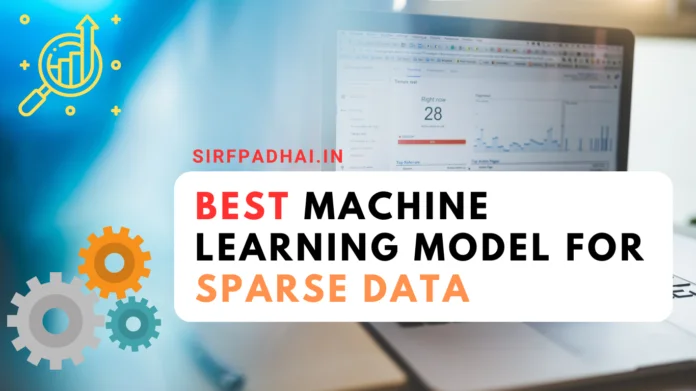Best machine learning model for sparse data
Are you tired of dense data taking over your life? Do you find yourself drowning in a sea of zeroes, struggling to extract insights from your sparse datasets? Fear not, dear reader! There’s a solution to your sparse data woes, and it comes in the form of machine learning models.
As data becomes more and more abundant, so too does its sparsity. Sparse data refers to datasets in which the vast majority of values are zero, making it difficult to apply traditional machine learning models. But fear not! There are a handful of machine learning models that excel at handling sparse data, and we’re here to explore the best of the best.
In this blog post, we’ll dive into the world of sparse data and explore the best machine-learning models to tackle it head-on. From logistic regression to gradient boosting, we’ll provide an overview of each model’s strengths and weaknesses and examine real-world examples of their applications to sparse datasets. And along the way, we might just crack a joke or two to keep things light-hearted.
So grab your coffee and get ready to learn about the best machine-learning models for sparse data. You never know, you might just find the solution to your sparse data struggles.
Understanding Sparse Data
Sparse data is a common challenge in the world of data science and machine learning. It refers to datasets in which the vast majority of values are zero, and can arise from a variety of sources such as missing data, feature engineering, or simply the nature of the data itself.
Understanding the causes of sparsity is an important first step in effectively handling sparse data. Some of the most common causes include data collection methods, such as surveys that only ask certain questions or sensor networks that only record data at certain times. Other causes can be related to the nature of the data itself, such as text data, which tends to be very high-dimensional and sparse.
To handle sparse data, a number of techniques have been developed. One common approach is to use feature selection methods to identify the most relevant features, and then build models only on those features. Another approach is to use regularization techniques such as L1 regularization, which encourages the model to use only a subset of the available features.
Additionally, specialized machine learning models have been developed specifically to handle sparse data, such as logistic regression, naive Bayes, and decision trees. These models are designed to be robust to sparsity and often perform better than traditional models on sparse datasets.
understanding the causes of sparsity and the techniques available for handling it is crucial for effectively analyzing and extracting insights from sparse datasets. By employing the right methods and tools, data scientists and machine learning practitioners can turn the challenges of sparse data into opportunities for innovation and discovery.
Best Machine Learning Models for Sparse Data
When it comes to sparse data, not all machine learning models are created equal. Some models simply aren’t designed to handle the challenges of sparsity, while others excel at making sense of sparse datasets. In this section, we’ll explore some of the best machine-learning models for sparse data.
Logistic regression is a popular choice for handling sparse data. It’s a simple and efficient model that can handle high-dimensional data with a relatively small number of training examples. Additionally, it performs well on datasets with a large number of features and can be easily interpreted.
Naive Bayes is another strong choice for sparse data, particularly when dealing with text data. It’s a probabilistic model that assumes that the features are conditionally independent given the class, making it computationally efficient and easy to train. Despite its simplicity, it has been shown to perform well on a variety of tasks.
Decision trees are versatile and interpretable models that can also handle sparse data. They work by recursively partitioning the feature space into regions, and can handle both continuous and categorical data. Additionally, decision trees can be used for feature selection and provide valuable insights into the underlying data.
Random forest and gradient boosting are two more powerful models that can handle sparse data. They both work by combining multiple weak learners to build a stronger overall model. Random forest is particularly useful for high-dimensional data with many irrelevant features, while gradient boosting can handle complex relationships between features.
By understanding the strengths and weaknesses of each of these models, data scientists and machine learning practitioners can select the best model for their specific use case and successfully extract insights from sparse data.
Comparing the Models
Now that we’ve explored some of the best machine learning models for sparse data, it’s important to compare and contrast their strengths and weaknesses to select the best model for a particular use case.
Logistic regression is a simple and efficient model that works well on datasets with a large number of features. However, it may struggle with non-linear relationships between features and can be sensitive to outliers.
Naive Bayes is particularly useful for text data and can handle high-dimensional data efficiently. However, it makes the strong assumption of conditional independence between features, which may not hold in all cases.
Decision trees are versatile and interpretable models that can handle both continuous and categorical data. However, they may overfit the training data and may not perform as well on very large or very sparse datasets.
Random forest and gradient boosting are powerful ensemble models that can handle complex relationships between features. However, they can be computationally expensive and may not be as interpretable as some of the other models.
Ultimately, the choice of model will depend on the specific use case and the particular characteristics of the dataset. By carefully considering the strengths and weaknesses of each model, data scientists and machine learning practitioners can select the best model for their needs and successfully extract insights from sparse data.
Best Practices for Working with Sparse Data
Working with sparse data can be challenging, but there are some best practices that can help data scientists and machine learning practitioners effectively handle sparse datasets.
One important best practice is to carefully preprocess the data. This can involve techniques such as imputation for missing values, normalization to reduce the impact of outliers, and feature scaling to ensure that all features have equal influence on the model.
Another best practice is to carefully choose the appropriate machine learning model for the specific use case. As we discussed earlier, some models are better suited for sparse data than others, so it’s important to carefully consider the strengths and weaknesses of each model before making a selection.
Feature selection is also important when working with sparse data. Choosing the most relevant features can help reduce the dimensionality of the dataset and improve the performance of the model. Techniques such as L1 regularization can be particularly useful for this purpose.
Finally, it’s important to carefully evaluate the performance of the model. This can involve techniques such as cross-validation to ensure that the model is generalizing well to new data, and careful analysis of the model’s predictions to understand any patterns or biases.
By following these best practices, data scientists and machine learning practitioners can effectively handle sparse data and extract valuable insights from even the most challenging datasets.
Conclusion
In conclusion, working with sparse data requires a careful approach that takes into account the unique challenges posed by these types of datasets. However, by following best practices such as careful preprocessing, appropriate model selection, feature selection, and rigorous evaluation, data scientists and machine learning practitioners can effectively handle sparse data and extract valuable insights.
We’ve explored some of the best machine learning models for sparse data, including logistic regression, naive Bayes, decision trees, random forest, and gradient boosting. Each of these models has its own strengths and weaknesses, and the best choice will depend on the specific use case and characteristics of the dataset.
Overall, the key to successfully working with sparse data is to carefully analyze the dataset and choose the most appropriate techniques and models to extract meaningful insights. By doing so, data scientists and machine learning practitioners can overcome the challenges of sparse data and make the most of even the most complex and challenging datasets.








